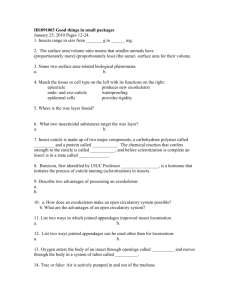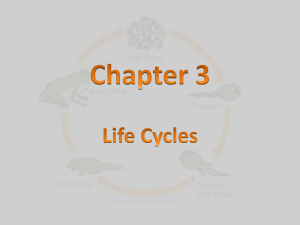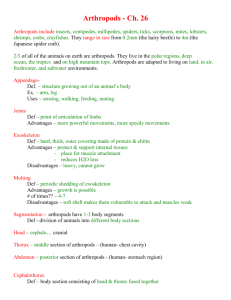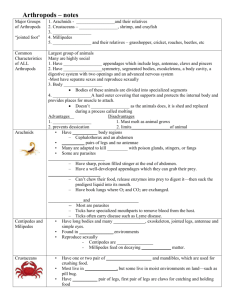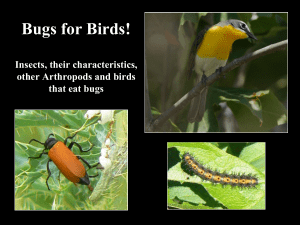1 ARTHROPOD (INSECT ZOO) TOUR Please do not bring food or
advertisement
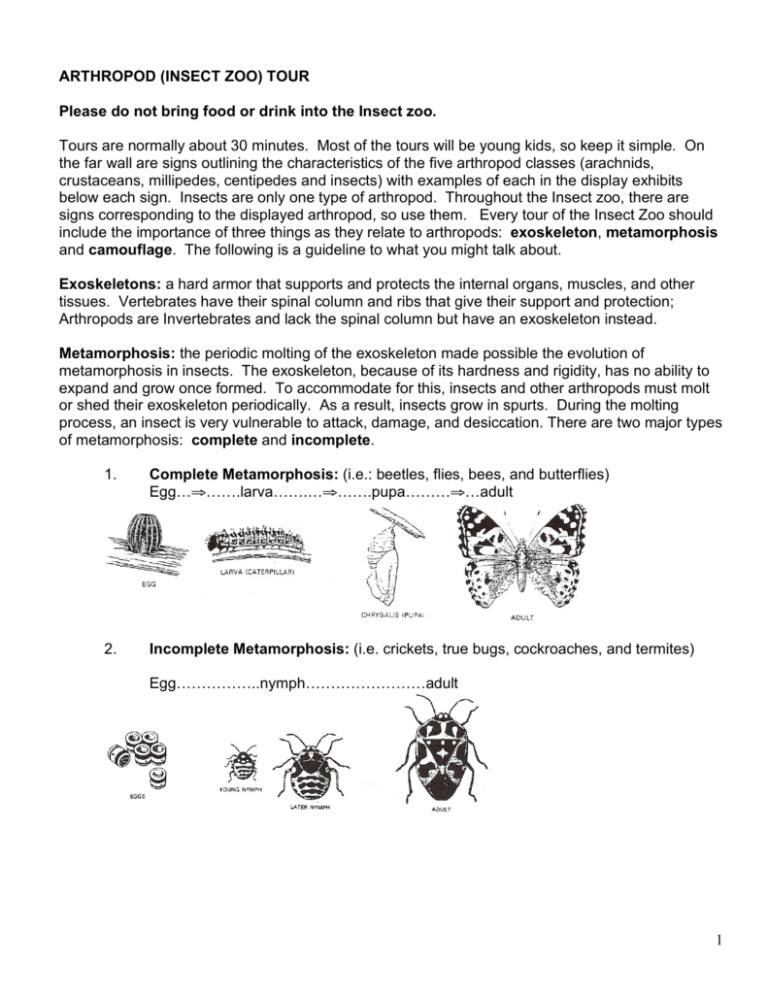
ARTHROPOD (INSECT ZOO) TOUR Please do not bring food or drink into the Insect zoo. Tours are normally about 30 minutes. Most of the tours will be young kids, so keep it simple. On the far wall are signs outlining the characteristics of the five arthropod classes (arachnids, crustaceans, millipedes, centipedes and insects) with examples of each in the display exhibits below each sign. Insects are only one type of arthropod. Throughout the Insect zoo, there are signs corresponding to the displayed arthropod, so use them. Every tour of the Insect Zoo should include the importance of three things as they relate to arthropods: exoskeleton, metamorphosis and camouflage. The following is a guideline to what you might talk about. Exoskeletons: a hard armor that supports and protects the internal organs, muscles, and other tissues. Vertebrates have their spinal column and ribs that give their support and protection; Arthropods are Invertebrates and lack the spinal column but have an exoskeleton instead. Metamorphosis: the periodic molting of the exoskeleton made possible the evolution of metamorphosis in insects. The exoskeleton, because of its hardness and rigidity, has no ability to expand and grow once formed. To accommodate for this, insects and other arthropods must molt or shed their exoskeleton periodically. As a result, insects grow in spurts. During the molting process, an insect is very vulnerable to attack, damage, and desiccation. There are two major types of metamorphosis: complete and incomplete. 1. Complete Metamorphosis: (i.e.: beetles, flies, bees, and butterflies) Egg…⇒…….larva…….…⇒…….pupa………⇒…adult 2. Incomplete Metamorphosis: (i.e. crickets, true bugs, cockroaches, and termites) Egg……………..nymph……………………adult 1 Camouflage: protective coloration and patterns making the animal difficult to find. Bright eyespots on body or wings fool predators into believing the insect is larger than it really is. Vivid coloration reminds predators these insects taste bad. Animals that mimic the coloration of inedible types are not dangerous but benefit from looking like ones that are. Phasmids (leaf and stick insects) are among the best-camouflaged animals, with a body shape and coloring that mimics the vegetation of their habitat, making them extremely difficult to spot. Topics for older tours: Why are insects so important? • Pollination – insects such as bees, flies, beetles, moths, ants, wasps, butterflies, and thrips pollinate over 80% of the world’s flowering plants. Without these insects, plants could not reproduce or bear fruit. Flower shape, color, nectar, and scent have evolved to attract their insect pollinators. (See the Insect Zoo’s honeybee exhibit for a list of plants.) • Decomposition – Insects speed up this process immensely, thereby helping to unlock nutrients and return them back to the earth. Termites help break down dead trees; carrion beetles break down carcasses and help control disease; others eat decaying leaves, fungi, etc. • Role in the food web – Insects and other arthropods are the main food of many different kinds of animals (song birds, shore birds, birds of prey, fish, lizards, reptiles, shrews, moles, rodents, bats, tamarins, numbats, bushbabies, etc., etc., etc.). In addition, insects themselves are major predators of other insects. Advantages of Metamorphosis: 1. Each life stage is specialized, which increases efficiency and success. For example, the larval stage is specialized as an eating machine. Its exoskeleton is softer so that it can grow a bit; the adult stage is specialized for reproduction and dispersal. 2. Competition for food and habitat resources within a species and within a population is reduced because the larva and adult often have different food habits and occupy different niches. In addition, there is often a seasonal separation of the adult and immature life stages also resulting in reduced competition. 3. With the aid of metamorphosis, insects, even with their small size, have the ability to withstand climatic extremes (cold, drought). Most insects can overwinter in an egg or pupal stage, which affords them protection from the climate and enables them to survive long periods when food is scarce. 2 Characteristics of all Arthropods (meaning “jointed foot”) Jointed, paired appendages Hard exoskeleton Bilateral symmetry Body divided into distinct regions THE FIVE MAJOR CLASSES OF THE PHYLUM ARTHROPODA (posted on far wall with examples of each below): ARACHNIDA (spiders, scorpions, mites, ticks, whip scorpions, solpugids) 4 pairs of legs 1 or 2 body regions (cephalothorax, abdomen) No wings No antennae Mostly terrestrial, some freshwater 35,000+ species CRUSTACEA (crayfish, crabs, shrimp, barnacles, sowbugs, copepods) 5 or more pairs of legs 2 body regions (cephalothorax, abdomen) No wings 2 pairs of antennae, usually Mostly marine, some freshwater, a few terrestrial 35,000+ species DIPLOPODA (millipedes) 2 pairs of legs on most body segments Cylindrical, multi-segmented body No wings 1 pair of antennae Terrestrial 8,000+ species CHILOPODA (centipedes) 1 pair of legs on most body segments Flattened, multi-segmented body No wings 1 pair of antennae Terrestrial 5,000+ species INSECTA (beetles, butterflies, wasps, grasshoppers, flies, termites, dragonflies, etc.) 3 pairs of legs 3 body regions (head, thorax, abdomen) 1 or 2 pairs of wings (sometimes absent) 1 pair of antennae Mostly terrestrial or fresh water, a few marine 1-30 million species 3 GLOSSARY: ARTHROPODS ARTHROPOD – “jointed-limbed” invertebrate with a hardened cuticle (exoskeleton), a condition believed to have evolved independently on several occasions – hence the separate phyla of “arthropods.” CAMOUFLAGE - a disguise, such as body coloring, pattern, or shape, that helps an animal blend with its surroundings making it less visible to predator or prey. CRYPTIC COLORATION - tending to conceal or camouflage by special coloration (e.g., chameleon). (See CAMOUFLAGE, MIMICRY) ECDYSIS – the process of shedding the exoskeleton; molting ECDYSONE – a hormone that influences ecdysis ENTOMOLOGY – The branch of zoology devoted to the study of insects EXOSKELETON – an external, waterproof, protective body covering, composed of chitin, sclerotin, and waxes, which houses and supports the internal organs, muscles, and other tissues. INVERTEBRATES - animals without backbones, such as jellyfish, snails, worms, spiders, and insects. METAMORPHOSIS – transformation of a larva, nymph, or naiad into an adult Complete – in which the insect passes through four distinct stages in its life cycle (egg, larva, pupa, and adult), and the immature stages do not resemble adults (also called holometabolous development) Incomplete – in which immature nymphs resemble adults of the species as soon as they hatch from the eggs. Their size increases with successive molts, as do the development of wings and sexual organs (also called hemimetabolous development) MIMICRY - the superficial resemblance in form, color, or behavior of certain organisms to other more powerful or more protective ones, resulting in protection, concealment, or some other advantage for mimic. MOLT – the shedding of the entire exoskeleton; all arthropods do this during growth and metamorphosis; the technical term is ecdysis VERTEBRATES - animals with backbones of bone or cartilage (e.g., fishes, amphibians, reptiles, birds, and mammals). (6/20/12) 4

